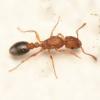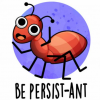In myrmecological/ecological/invasive insect studies there is what is known as 'invasive ant syndrome'. Invasive ants share many ecological and life-history traits. Together, these traits are often referred to as the ‘‘invasive syndrome’’. All of these species form large polygynous colonies, covering extensive territories, and they have very generalist diet, nesting and habitat requirements and foraging strategies. It is likely that these invasive ant species will compete for the same resources and displace one another, unlike dominant ants in native communities, which often differ from subordinates in their diet preferences and/or foraging strategies. In addition, in native communities interspecific trade-offs, for example in the ability to discover and to defend resources, promote species co-existence. Invasive species, however, are generally thought to avoid these trade-offs by being simultaneously very fast at discovering resources and able to dominate them. Generally, invasive species have exceptional phenotypic plasticity meaning, when confronted with novel ecological contexts that are able to successfully establish themselves and particularly displace endemic species with regard resource acquisition.





















